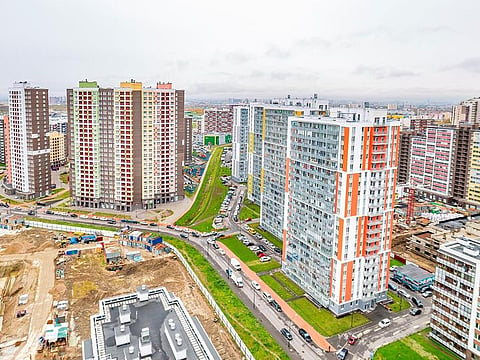India’s property market again turns to NRIs to boost demand for homes
Rupee at over 21/Dh could help Indian expats add to their property assets

Dubai: India’s property market and its developers will once again be looking overseas – at Indian expats – to sustain the strong recovery in demand for homes across most cities seen since last year. Because with a second successive interest rate hike, financing a home purchase has suddenly turned a whole lot more expensive for domestic buyers.
The base interest rate in India is at 4.90 per cent, while the mortgage rate is anywhere from 6.50 per cent. The hike in interest rates will, according to market watchers, could end up pushing property demand into the ‘red zone’.
“Any future hikes will reflect markedly on housing sales,” said Anuj Puri, Chairman of Anarock Group, the property consultancy. “The rate hike will undoubtedly push up home loan interest rates, which had already begun creeping upward after the surprise monetary policy announcement last month (when the RBI effected a 0.40 per cent increase).
This is why developers are keen to get Indian expats to pick up any slack in demand in the coming months. While NRIs were keen participants in the last 18 months, it was domestic buyers that were at the forefront of helping clear unsold housing stock, helped by government announcements on lower stamp duty and easy access to home finance after the Covid shock to the economy.
Developers matched those government boosters with their own incentives, using discounts to telling effect. Now, those are winding down, including the lower stamp duties.
“The pandemic and underlying uncertainties prompted many developers to re-strategize and be prepared for most eventualities,” said Puri. “As such, they are better prepared today than they were earlier. As for incentives, many of the offers and discounts previously rolled out by developers have expired. But for projects/cities where there is ample supply, there are still incentives being offered.”
Delhi is definitely doing better
Before the Covid outbreak, Delhi’s NCR (National Capital Region) residential market ‘lagged far behind its Southern counterparts’ as it grappled with delayed project deliveries and policy interventions like demonetisation, creation of RERA, and GST. But the post-Covid period has been a completely different revelation when it comes to NCR. Latest data from Anarock show NCR's unsold inventory down 12 per cent in Q1-2022 against pre-pandemic Q1-2020, while Bengaluru, Hyderabad and Chennai saw their combined unsold stock increase 32 per cent. The MMR (Maharashtra Metropolitan Region) and Pune saw their cumulative unsold stock reduce 10 per cent. “Interestingly, this is the first time that in a quarter, NCR’s total unsold stock clocked in lower than in South India's collective unsold stock,” said Anuj Puri of Anarock. “In MMR and Pune, the unsold stock declined by 10 per cent between the pre and post-pandemic periods - from 307,000 units by Q1-2020 to 275,000 units in Q1-2022. “However, it bears highlighting that this rise in unsold inventory was primarily because of a massive new launch rate in Hyderabad.”
Weak rupee will be key
The Indian rupee has been weaker in recent weeks, going below 21 to the dirham for the first time on May 9. Market analysts say hitting 22 will likely happen sooner than might have been the case earlier.
Whether to buy a home or property in India and taking out mortgage to finance it, the rupee’s weakness translates into strength for expats.
According to Dr. Niranjan Hiranandani, Vice-Chairperson of the real estate grouping NAREDCO and Managing Director of Mumbai-based Hiranandani Group, potential buyers should wait for the upcoming festival season to look at new offplan launches.
“Robust demand for homes amidst Covid was driven by low interest rates, stamp duty waivers, and incentives doled out by developers,” he said. “This nudged the residential market to offload the huge unsold inventory overhang. Developers are now geared up for new launches.
When will next rate hike happen?
At its last meeting, the Reserve Bank of India upped its forecasts on what the inflation could be for the current financial year. The moot point is whether RBI follows the lead of the US Federal Reserve with a succession of rate hikes. That, when reflected in mortgage lending rates, could take out a significant portion of the demand in the mid- and budget housing spaces.
Again, that would place an extra onus on NRI support to keep pitching in with the buys. Developers, no doubt, will be taking a lot of strength from any further weakening of the rupee against leading currencies, including the dirham.
Inflation higher, but check out GDP
Ramesh Nair, CEO of India operations at Colliers, reckons now would be a good time to get into the market. “We expect banks to gradually pass on this rise in the form of higher home loan rates in the coming months,” said Nair. “An opportune time for homebuyers to take advantage of the prevailing home loan rates at a time when prices are also expected to rise in most of the markets led by revival in demand.
If it happens, India’s developers can surely make do with that confidence boost – meantime, they will wait for buyers to keep turning up. And a whole lot of prospective NRI homeowners…
Sign up for the Daily Briefing
Get the latest news and updates straight to your inbox







